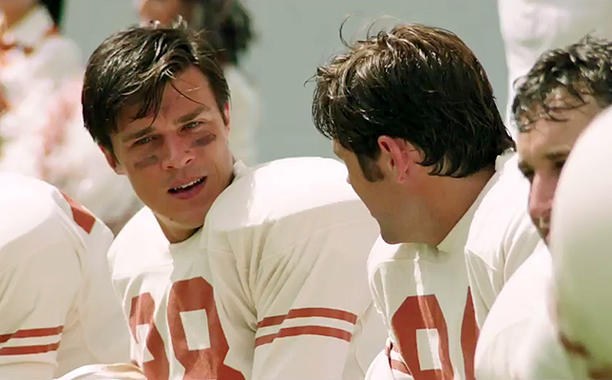My All American
Posted on November 12, 2015 at 5:32 pm
If I wrote this review the way writer-director Angelo Pizzo wrote the script for “My All American,” it would be something like this: I saw a movie. It was about football. Freddie Steinmark worked hard and inspired his team, but then got sick. It was sad. 
Pizzo wrote two of the best sports films of all time, “Rudy” and “Hoosiers,” but here, in another real-life sports story, he has decided that the audience needs a kind of running commentary from every character to explain — instead of show — the audience what is going on. In an early scene, Steinmark’s mother (Robin Tunney) tells him that because he is smaller than his friends, he will have to work harder. Later, other characters tell us repeatedly what we should be able to see: that he works harder than everyone else, that he is religious, even that he is handsome. This is a movie where a coach actually says that Steinmark has courage and guts. The dialogue is so exposition-heavy that it is like sawing lumber.
It is good to see a biopic that does not rely on the usual scenes of the girlfriend complaining that the lead character does not spend enough time with her. But Steinmark is portrayed as such an all-around saint that he is bland, without any character beyond niceness and determination. All of the characterizations are paper-thin. It is as though everyone on the screen is just another color commentator, not a character.
Steinmark (Finn Wittrock of “The Big Short”) is the son of hard-working Catholics. His father has two jobs, security guard by day, cop at night, but is so dedicated to his son’s athletics that he never misses a practice or a game. When a teammate suggests that perhaps Steinmark’s father is living his own dreams of an athletic career through his son, Freddie says no and the subject never comes up again. Freddie wants to play for Notre Dame and then the Chicago Bears. But college coaches think he is too small — except for Darrell Royal (Aaron Eckhart) at the University of Texas, who recruits Steinmark and his best friend. Steinmark’s devoted girlfriend, Linda (Sarah Bolger, one of the adorable Irish girls from “In America”), is accepted to UT as well.
Steinmark is so remarkable (as everyone keeps telling us and telling us and telling us) that he is made first-string in his sophomore year. He leads the defense so successfully that the championship is within reach. And then he begins to have a problem with his leg.
There are very clumsy attempts to do what “Rudy” and “Hoosiers” did in creating a sense of time and place. Here, the references to the war in Vietnam (and the protests), the moon landing, long hair, and 60’s songs are jarring and haphazard. The absence of any person of color may be authentic as regards the team, but on the campus? In the hospital? It is so strange that it becomes a distraction. The framing story of an interview decades later with Royal adds nothing. The football scenes are capably staged, but do not move the story forward.
There are references to Steinmark’s faith — he goes to mass every day and we see him pray and encourage his friend to pray. But we never get a sense of what the faith means to him or how it helps him understand his illness. There is more drama and more character in a throwaway scene involving another player who loses his position than there is in the portrayal of Steinmark’s story.
And there is only the slightest reference to one of the most interesting parts of the story; the lack of treatment options for someone with cancer in 1969. Steinmark’s diagnosis came just before the United States made its first major commitment to a “war on cancer,” with federal funds being used for research. This is the kind of context that could have provided the story with the impact it fails to muster.
Parents should know that there is brief strong language and a brief view of a bare tush, as well as discussions of serious illness and a sad death.
Family discussion: Were you surprised by Bill’s reaction to being replaced? What was it about Steinmark that made him so important to his coach?
If you like this, try: “Rudy,” “Hoosiers,” and “The Express”



